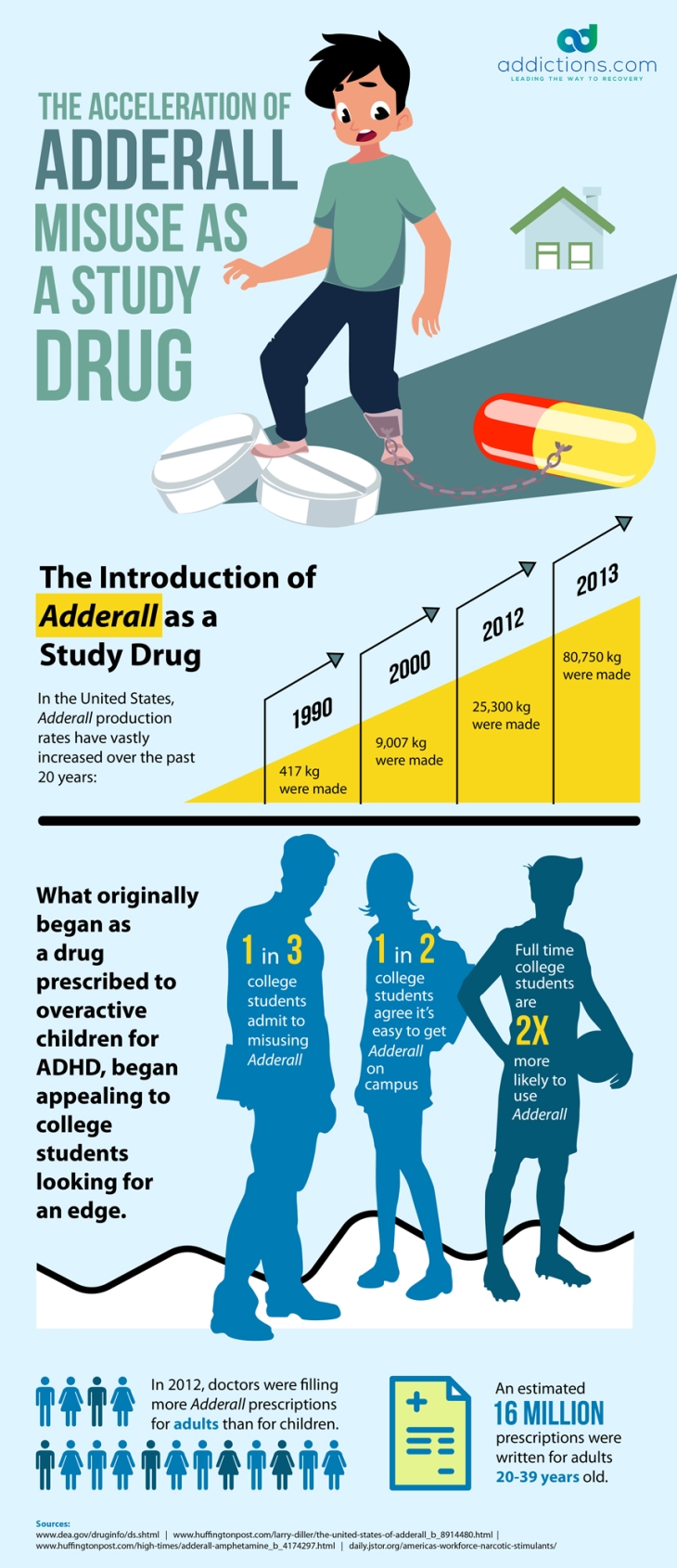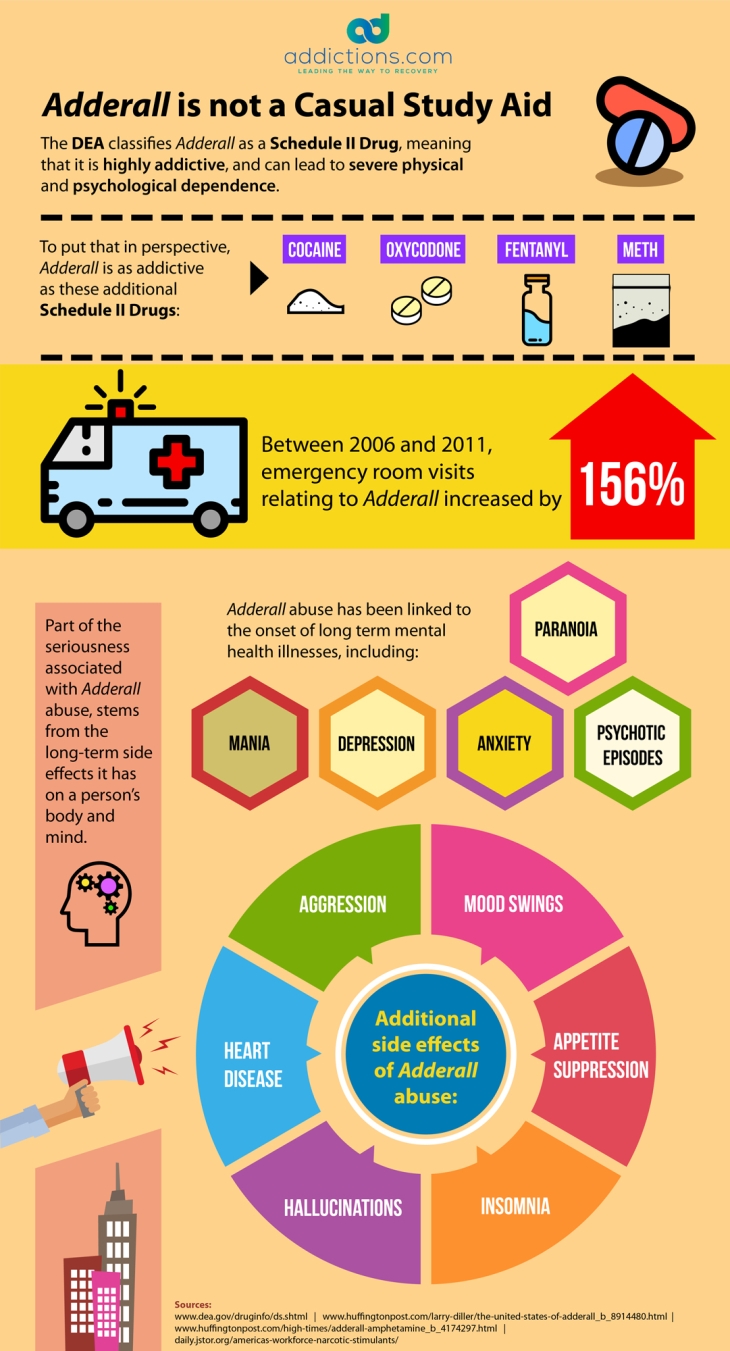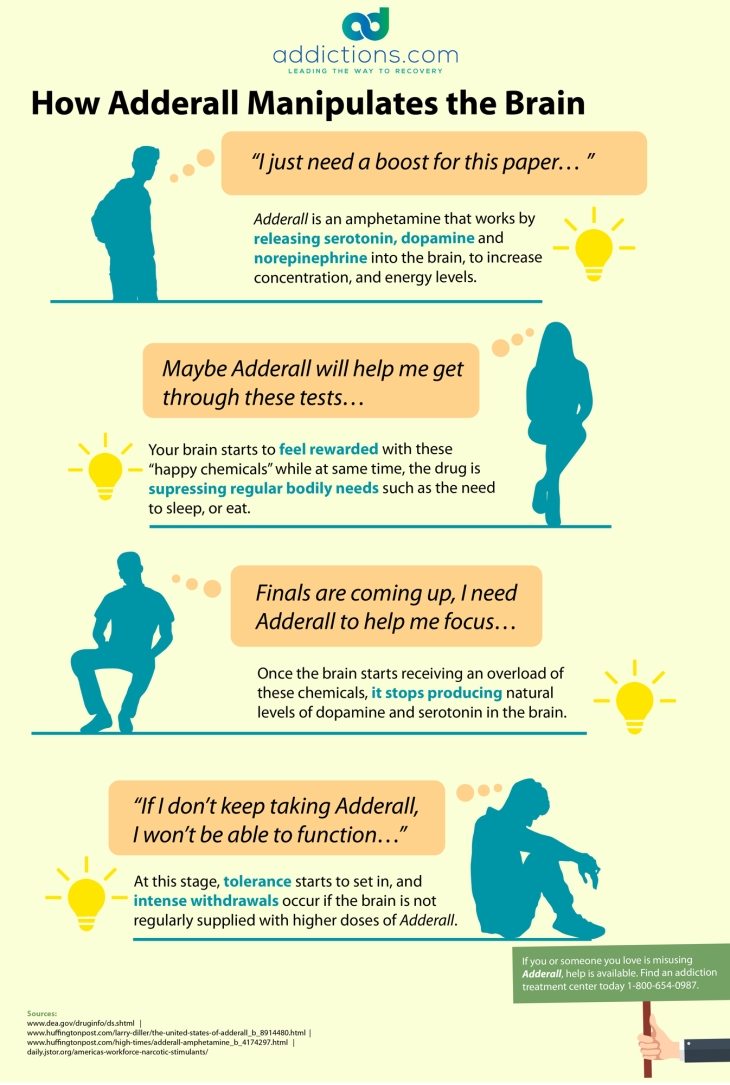Adderall is a stimulant commonly prescribed to treat ADHD in children and adults. ADHD is a chronic health condition marked by low energy and problems with focus and concentration. Adderall works by stimulating the central nervous system to boost attention and energy — allowing these individuals to perform better at school or work and improve other ADHD symptoms.
In 2003, nearly eight percent of youth in the US between the ages of four and 17 were diagnosed with ADHD, according to the CDC. This percentage rose to 9.5 percent in 2007, and to 11 percent in 2011. With ADHD rates in the US steadily on the rise, a higher number of children, teens, and young adults are becoming more familiar with Adderall and its effects.
Today, Adderall is unofficially known as one of many “study drugs” — substances believed to enhance a student’s focus, concentration, and study sessions. Kids and young adults without ADHD are using Adderall and other study drugs without understanding the serious health risks associated with these substances. Adderall being used as a study drug is leading to the acceleration of Adderall addiction, and to a number of other serious lifelong problems for those who abuse this medication.
Here’s an in-depth look at why Adderall is being used as a study drug, along with the dangers associated with Adderall abuse among children and young adults.
How Did Adderall Become a Study Drug?
Rising ADHD Rates in the US
Researchers are still unsure as to how exactly Adderall became known as a study drug, but suspect that rising ADHD rates in the US are contributing to this study drug epidemic. As more Americans become diagnosed with ADHD, families and communities are becoming increasingly familiar with the condition and how it can be treated using Adderall. People are also becoming more aware of the stimulant effects of Adderall, and how this drug increases alertness and concentration in those with ADHD.
In the 1980s, only one in every 20 US youth were diagnosed with ADHD, but today, roughly one in every nine kids have ADHD. A 2014 study revealed that the growth of ADHD is not strictly related to medical reasons, and that the condition has become more widespread due to a number of other influential factors. Factors cited in the study include increased marketing and advertising for ADHD drugs such as Adderall and Ritalin, the rise of US-style psychology involving the use of prescription drugs, and the rise of ADHD awareness among Americans who can research symptoms on the Internet, self-diagnose, and visit their doctors to obtain prescriptions.
In 1990, only 417 kg of Adderall was manufactured for use in treating ADHD in the US. In 2012, this amount jumped to 25,300 kg. Since the DEA only allows for a certain amount of Adderall to be manufactured each year, Congress has voted on increasing the yearly quota to meet the rising demands of consumers.
The Rise in Illicit Adderall Use
Google Trends reveals that search activity for the word “Adderall” has increased steadily year over year since 2005. However, Google Trends shows that Adderall didn’t start rising in popularity as a study drug until 2009, which is when the query “Adderall studying” first hit the map. Analytics reports show that searches for “Adderall studying” usually hit their peak in May and December during finals, but flatline during the summer when school is out of session. These findings further indicate the widespread use of Adderall as a study drug.
People who are not diagnosed with ADHD and who want to use Adderall for recreation or performance can easily obtain the drug from friends and family members who have valid prescriptions. These individuals may steal or take Adderall without their loved ones knowing, or buy Adderall from friends at school or dealers on the street. Adderall can even be purchased without a prescription at low costs from illegal black-market websites on the dark web.
A SAMHSA report reveals that full-time college students are twice as likely to use Adderall for nonmedical reasons than part-time college students. Another study involving college students reveals that 50 percent of students strongly agree that prescription stimulants like Adderall are easy to obtain on campus. Additionally, 60 percent of those surveyed reveal they know students who abuse stimulants, while 7.5 percent admit to having used a non-prescription stimulant within the last 30 days.
Different Types of Study Drugs
Adderall is just one of many study drugs commonly abused in the US. Most study drugs fall into the stimulant drug class — drugs that stimulate the central nervous system to increase alertness, energy, and attention. Examples of drugs that belong to the stimulant drug class include prescription drugs Adderall and Ritalin, and illicit drugs cocaine and methamphetamine.
Adderall is classified a Schedule II drug by the DEA. Schedule II drugs offer a high potential for abuse and addiction, and considered dangerous. Other drugs that fall into the Schedule II drug class alongside Adderall are fentanyl, oxycodone, and cocaine.
The following prescription drugs are commonly abused as study drugs:
- Adderall
- Attenta
- Concerta
- Dexedrine
- Methylin
- Modafinil
- Ritalin
- Vyvanse
When misused, all study drugs can lead to physical dependence and addiction, as well as to the development of serious long-term health problems later in life. Some health conditions triggered by abusing study drugs cannot often be fully cured, and may require lifelong medical treatment. For instance, Adderall use disorder has been found to increase the risk for bipolar disorder, which can be effectively treated using a combination of antidepressants and behavioral counseling.
Why Students Are Highly Susceptible to Adderall Abuse
High school and college students are often under lots of pressure to maintain good grades and perform well in school. Many full-time students also manage other important responsibilities outside of school such as jobs and family — making it even more difficult to find time for homework and studying. Students are generally more susceptible to Adderall use disorders since the drugs allow them to increase concentration and focus while also allowing them to stay up late and participate in other activities.
A 2008 study reveals that chronic stress is a major risk factor contributing to drug abuse among students. Instead of coping with stress directly using healthy, effective methods, students rely on alcohol and drugs like Adderall to cope with stress and anxiety without addressing the core problem.
Many parents of children diagnosed with ADHD have raised concerns about whether Adderall can increase their children’s risk for drug abuse and addiction later in life. The National Institute of Drug Abuse says that studies examining a possible link between ADHD medication and addiction find no correlation between the two. When Adderall is used as prescribed to treat certain medical conditions, the drug carries little to no risk for addiction — even in children.
Conversely, other studies do show that ADHD medication may increase the risk for substance use disorders later in life — especially for those who exhibit certain risk factors. For instance, children with ADHD and a family history of addiction may be at higher risk for suffering Adderall addiction. Adults with ADHD are also more likely to suffer problems with substance abuse than those without this disorder.
Risks Associated with Adderall Addiction
Adderall is an FDA-approved medication used for treating narcolepsy, ADHD, and depression, in rare cases. When used as directed, Adderall increases blood flow and heart rate to produce feelings of increased energy, alertness, and attention. But when misused, Adderall can produce feelings of euphoria and intense bursts of energy followed by a crash. After the initial positive effects of Adderall wear off, those who abuse this stimulant can experience fatigue, depression, and further difficulty with focus and concentration.
Common signs of Adderall addiction:
- Feelings of anxiety and nervousness
- Loss of appetite
- Weight loss
- Restlessness
- Nausea and vomiting
- Insomnia
- Irritability
- Mood swings
A 2016 study shows that Adderall abuse is rising among young adults between 18 and 25 who are not diagnosed with ADHD. Adderall use among adults who don’t have ADHD has risen by 67 percent in recent years, and emergency room visits associated with Adderall use disorders increased by 156 percent from 2006 to 2011.
Those who become addicted to Adderall are at higher risk for serious health problems due to this way this stimulant affects the central nervous system. Common side effects of Adderall addiction include increased heart rate, circulation, and blood pressure, along with blurred vision and headaches. Many individuals addicted to Adderall also report experiencing constipation and gastrointestinal problems.
Adderall increases the brain’s production of dopamine — a brain chemical responsible for controlling emotions and feelings of pleasure. When people misuse Adderall over a long period of time, the brain stops producing dopamine on its own, which makes the body physically dependent on Adderall for feelings of pleasure. Those who become dependent on Adderall will suffer withdrawal symptoms such as fatigue, irritability, and insomnia when reducing use. These individuals often require certain doses of Adderall to function “normally” throughout the day without experiencing these adverse effects.
Adderall misuse, and Adderall use disorders can cause lasting damage to the heart and cardiovascular system. Suffering from consistently high blood pressure increases the risk for heart disease, stroke, and death. Fortunately, Adderall addiction can be effectively treated at most drug and alcohol rehab centers.
How is Adderall Addiction Treated?
Adderall addiction is commonly treated using detoxification and counseling. Detox helps patients overcome physical dependency on Adderall, while behavioral therapy and group counseling helps patients overcome psychological root causes of addiction.
Adderall detox is often performed using a tapering method, which is when doctors reduce a patient’s dosage gradually over time until they are no longer dependent on the medication. This process can often take weeks or months — depending on the severity of the patient’s addiction. Some treatment centers may have patients quit Adderall cold turkey, and prescribe other medications that reduce certain withdrawal symptoms to make recovery more comfortable.
Following Adderall detox, many patients are treated for addiction in an inpatient or outpatient setting. Behavioral counseling, 12-step support groups, and group and family counseling are common addiction treatments that teach patients how to navigate daily life without feeling urges to use Adderall.
What Are Safe Alternatives to Adderall for Studying?
Many times, problems with energy, focus, and concentration stem from one’s everyday lifestyle habits. For instance, lack of sleep can put undue stress on the body and lead to problems with energy, focus, and concentration. Eating a diet high in fat and sugar can also lead to serious problems with fatigue and interfere with brain health.
Here are safe, healthy alternatives to Adderall if you commonly face problems with studying:
- Get plenty of quality sleep. Quality sleep naturally reduces stress and repairs your mind and body so you can benefit from improved energy and concentration. Make changes to your sleep environment as needed so you can get more sleep and feel refreshed in the morning.
- Exercise regularly. Exercise improves your blood flow and circulation so you can benefit from higher energy levels and increased focus throughout the day.
- Eat healthy foods. Certain foods are packed with antioxidants, vitamins, and other nutrients that naturally boost energy and brain function, while junk foods can make you feel more fatigued and cloudy. Start consuming more healthy, whole foods like leafy greens, fish, and berries that lend to improved brain health.
- Manage stress. Work on eliminating stressors from your daily life, or manage stress using healthier methods such as exercise, deep breathing, or listening to relaxing music.
- Stop multitasking. While multitasking may seem like a productive way to save time and get things done, studies show that multitasking is actually more time-consuming than doing things one at a time, and can lead to more confusion.
- Put away your mobile device. Text messages, social media, and app games are time-consuming and can easily distract you from your studies. Keep your smartphone or tablet in a place out of eyesight where it won’t cause distractions.
Adderall addiction can lead to serious problems involving finances, relationships, and the law, and can worsen your personal health and overall quality of life.



